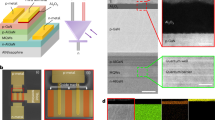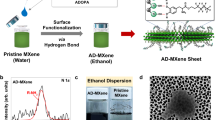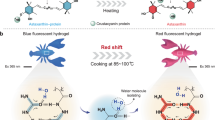Abstract
In the context of the fast-growing demand for innovative high-performance display technologies, the perspective of manufacturing low-cost functional materials that can be easily processed over large areas or finely printed into individual pixels, while being mechanically deformable, has motivated the development of novel electronically active organic components fulfilling the requirements for flexible displays and portable applications. Among all technologies relying on a low-power stimulated optical change, non-emissive organic electrochromic devices (ECDs) offer the advantage of being operational under a wide range of viewing angles and lighting conditions spanning direct sunlight as desired for various applications including signage, information tags and electronic paper. Combining mechanical flexibility, high contrast ratios and fast response times, along with colour tunability through structural control, polymeric electrochromes constitute the most attractive organic electronics for tomorrow’s reflective/transmissive ECDs and displays1,2,3. Although red, blue4 and most recently green5,6,7,8,9,10 electrochromic polymers (ECPs) required for additive primary colour space were investigated, attempts to make saturated black ECPs have not been reported, probably owing to the complexity of designing materials absorbing effectively over the whole visible spectrum. Here, we report on the use of the donor–acceptor approach to make the first neutral-state black polymeric electrochrome. Processable black-to-transmissive ECPs promise to affect the development of both reflective and transmissive ECDs by providing lower fabrication and processing costs through printing, spraying and coating methods, along with good scalability when compared with their traditional inorganic counterparts1,11,12.
This is a preview of subscription content, access via your institution
Access options
Subscribe to this journal
Receive 12 print issues and online access
$259.00 per year
only $21.58 per issue
Buy this article
- Purchase on Springer Link
- Instant access to full article PDF
Prices may be subject to local taxes which are calculated during checkout




Similar content being viewed by others
References
Reynolds, J. R. et al. Multicolored electrochromism in polymers: Structures and devices. Chem. Mater. 16, 4401–4412 (2004).
Sonmez, G. Polymeric electrochromics. Chem. Commun. 5251–5259 (2005).
Sonmez, G. & Wudl, F. Completion of the three primary colours: The final step toward plastic displays. J. Mater. Chem. 15, 20–22 (2005).
Skotheim, T. A. & Reynolds, J. R. Handbook of Conducting Polymers 3rd edn (CRC Press, Boca Raton, 2007).
Sonmez, G., Shen, C. K. F., Rubin, Y. & Wudl, F. A red, green, and blue (RGB) polymeric electrochromic device (PECD): The dawning of the PECD era. Angew. Chem. Int. Ed. 43, 1498–1502 (2004).
Durmus, A., Gunbas, G. E., Camurlu, P. & Toppare, L. A neutral state green polymer with a superior transmissive light blue oxidized state. Chem. Commun. 3246–3248 (2007).
Chang, C.-W. & Liou, G.-S. Stably anodic green electrochromic aromatic poly(amine-amide-imide)s: Synthesis and electrochromic properties. Org. Electron. 8, 662–672 (2007).
Chang, C.-W., Hsiao, S.-H. & Liou, G.-S. Highly stable anodic green electrochromic aromatic polyamides: Synthesis and electrochromic properties. J. Mater. Chem. 17, 1007–1015 (2007).
Gunbas, G. E., Durmus, A. & Toppare, L. Could green be greener? novel donor-acceptor-type electrochromic polymers: Towards excellent neutral green materials with exceptional transmissive oxidized states for completion of RGB color space. Adv. Mater. 20, 691–695 (2008).
Beaujuge, P. M., Ellinger, S. & Reynolds, J. R. Spray processable green to highly transmissive electrochromics via chemically polymerizable donor-acceptor heterocyclic pentamers. Adv. Mater. 20, 2772–2776 (2008).
Somani, P. R. & Radhakrishnan, S. Electrochromic materials and devices: Present and future. Mater. Chem. Phys. 77, 117–133 (2003).
Monk, P. M. S., Mortimer, R. J. & Rosseinsky, D. R. Electrochromism and Electrochromic Devices (Cambridge Univ. Press, Cambridge, 2007).
Deb, S. K. Novel electrophotographic system. Appl. Opt. Suppl. 192–195 (1969).
Azens, A. & Granqvist, C. G. Electrochromic smart windows: Energy efficiency and device aspects. J. Solid State Electrochem. 7, 64–68 (2003).
Granqvist, C. G. Oxide electrochromics: Why, how, and whither. Sol. Energy Mater. Sol. Cells 92, 203–208 (2008).
Argun, A. A., Cirpan, A. & Reynolds, J. R. The first truly all-polymer electrochromic devices. Adv. Mater. 15, 1338–1341 (2003).
Möller, M., Asaftei, S., Corr, D., Ryan, M. & Walder, L. Switchable electrochromic images based on a combined top-down bottom-up approach. Adv. Mater. 16, 1558–1562 (2004).
Monk, P. M. S., Delage, F. & Costa Vieira, S. M. Electrochromic paper: Utility of electrochromes incorporated in paper. Electrochim. Acta 46, 2195–2202 (2001).
Corr, D. et al. Coloured electrochromic ‘paper-quality’ displays based on modified mesoporous electrodes. Solid State Ion. 165, 315–321 (2003).
Kobayashi, T. et al. Polyaniline film-coated electrodes as electrochromic display devices. J. Electroanal. Chem. 161, 419–423 (1984).
Holmes, A. B. et al. Efficient photodiodes from interpenetrating polymer networks. Nature 376, 498–500 (1995).
Friend, R. H. et al. Laminated fabrication of polymeric photovoltaic diodes. Nature 395, 257–260 (1998).
Kim, Y. et al. Organic photovoltaic devices based on blends of regioregular poly(3-hexylthiophene) and poly(9,9-dioctylfluorene-co-benzothiadiazole). Chem. Mater. 16, 4812–4818 (2004).
Alam, M. M. & Jenekhe, S. A. Efficient solar cells from layered nanostructures of donor and acceptor conjugated polymers. Chem. Mater. 16, 4647–4656 (2004).
Veenstra, S. C. et al. Photovoltaic properties of a conjugated polymer blend of MDMO-PPV and PCNEPV. Chem. Mater. 16, 2503–2508 (2004).
Li, Y. et al. Synthesis and photovoltaic properties of two-dimensional conjugated polythiophenes with bi(thienylenevinylene) side chains. J. Am. Chem. Soc. 128, 4911–4916 (2006).
Kietzke, T., Egbe, D. A. M., Horhold, H. H. & Neher, D. Comparative study of M3EH-PPV-based bilayer photovoltaic devices. Macromolecules 39, 4018–4022 (2006).
Heeger, A. J. et al. Efficient tandem polymer solar cells fabricated by all-solution processing. Science 317, 222–225 (2007).
Marder, S. R. et al. A high-mobility electron-transport polymer with broad absorption and its use in field-effect transistors and all-polymer solar cells. J. Am. Chem. Soc. 129, 7246–7247 (2007).
Salzner, U. Does the donor–acceptor concept work for designing synthetic metals? 1. Theoretical investigation of poly(3-cyano-3′-hydroxybithiophene). J. Phys. Chem. B 106, 9214–9220 (2002).
Salzner, U. & Kose, M. E. Does the donor–acceptor concept work for designing synthetic metals? 2. Theoretical investigation of copolymers of 4-(dicyanomethylene)-4h-cyclopenta[2,1-b:3,4-b′] dithiophene and 3,4-(ethylenedioxy)thiophene. J. Phys. Chem. B 106, 9221–9226 (2002).
Stille, J. K. The palladium-catalyzed cross-coupling reactions of organotin reagents with organic electrophiles [new synthetic methods (58)]. Angew. Chem. Int. Ed. 25, 508–524 (1986).
CIE No. 15.2004, Colorimetry, 3rd edn (Commission Internationale de l’Eclairage, Vienna, Austria, 2004).
Havinga, E. E., Hoeve, W. & Wynberg, H. Alternate donor–acceptor small-band-gap semiconducting polymers; Polysquaraines and polycroconaines. Synth. Met. 55, 299–306 (1993).
Wudl, F. et al. A processable green polymeric electrochromic. Macromolecules 38, 669–675 (2005).
Gunes, S., Neugebauer, H. & Sariciftci, N. S. Conjugated polymer-based organic solar cells. Chem. Rev. 107, 1324–1338 (2007).
Thompson, B. C. & Fréchet, J. M. J. Polymer-fullerene composite solar cells. Angew. Chem. Int. Ed. 47, 58–77 (2008).
Acknowledgements
The authors thank the AFOSR (FA9550-06-1-0192) for financial support.
Author information
Authors and Affiliations
Corresponding author
Supplementary information
Supplementary Information
Supplementary Information (PDF 415 kb)
Rights and permissions
About this article
Cite this article
Beaujuge, P., Ellinger, S. & Reynolds, J. The donor–acceptor approach allows a black-to-transmissive switching polymeric electrochrome. Nature Mater 7, 795–799 (2008). https://doi.org/10.1038/nmat2272
Received:
Accepted:
Published:
Issue Date:
DOI: https://doi.org/10.1038/nmat2272
This article is cited by
-
Promising thermal photonic management materials for sustainable human habitat
Nano Research (2024)
-
Oxidative (co)polymerization of dithiarubicene derivatives and electrochromic properties of narrow-bandgap conjugated polymers
Polymer Journal (2022)
-
Colorless-to-colorful switching of electrochromic MXene by reversible ion insertion
Nano Research (2022)
-
Green revolution in electronic displays expected to ease energy and health crises
Light: Science & Applications (2021)
-
Synthesis, photophysical properties, and computational studies of benzothiadiazole and/or phenothiazine based donor/acceptor π-conjugated copolymers
Journal of Polymer Research (2021)



